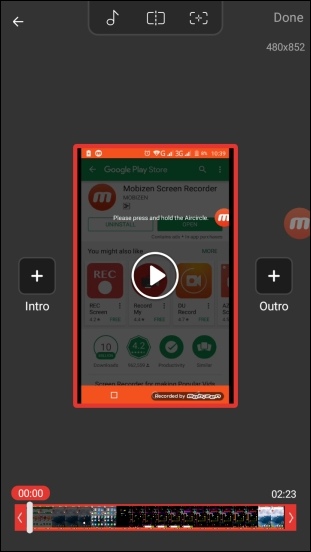

#Capture video intent android studio code
I am able to get my code to work on an Android 2.2 emulator, but it will not work on my device, Motorola Droid 1 stock 2.2 FRG22D.

Listing 1.4: The MainActivity class package am writing a very small app that just opens the camera app ready for video. showCamera constructs a built-in Intent and passes it to startActivityForResult to activate the video-making feature in Camera. String: ACTIONVIDEOCAPTURE: Standard Intent action that can be sent to have the camera application capture a video and return it. In short, pressing the Camera button on the action bar calls the showCamera method. ACTIONIMAGECAPTURESECURE: Intent action that can be sent to have the camera application capture an image and return it when the device is secured (e.g. You should know by now that the onOptionsItemSelected method is called when the menu item is pressed. There is only a FrameLayout with a VideoView element that is used to display the video file.įinally, the MainActivity class is presented in Listing 1.4. The activity also uses the layout file in Listing 1.3 to set its view. Listing 1.2: The menu file (menu_main.xml) Follow the path app > manifests > AndroidManifest.xml and paste the following piece of code in it.
#Capture video intent android studio how to
The currently displayed content is broadcasted as configurable MJPEG stream over http protocol. If you don’t know how to create a new project in Android Studio then you can refer to How to Create/Start a New Project in Android Studio Step 2: Adding storage permission. The activity reads the menu file in Listing 1.2 to populate its action bar. Edit this Doc Android Device Screen Streaming With Appium Since Appium 1.16 there is a possibility to stream the screen of the device under test to one or more remote clients. There is only one activity in the application, the MainActivity activity. Listing 1.1: The AndroidManifest.xml file

The AndroidManifest.xml file in Listing 1.1 shows the activity used in the application as well as a use-feature element. protected void onActivityResult(int requestCode, int resultCode, data) If you are interested in saving or processing the captured video, you must override onActivityResult. When you exit from Camera, either by canceling the operation or when you are done making a video, the system will resume your original activity (the activity where you called startActivityForResult) and call its onActivityResult method. Using the Screen Capturer API Setup your app Manifest Initialize a Video View Request screen capture permission from user Request Screen Capturer Permission. This method will pause the current activity and start Camera and make it ready to capture a video. The application will consist of a single button which, when touched by the user, will launch the video capture intent. Then put the output image Uri as the extra parameter pass to. You can choose any integer for the request code that you will pass as the second argument to startActivityForResult. In the remainder of this chapter, a very simple application will be created to demonstrate the use of the video capture intent. First you need create an Intent object with action MediaStore.ACTIONIMAGECAPTURE (android. StartActivityForResult(intent, requestCode) īasically, you need to create an Intent object by passing MediaStore.ACTION_VIDEO_CAPTURE to its constructor and pass it to the startActivityForResult method in your activity class. Intent intent = new Intent(MediaStore.ACTION_VIDEO_CAPTURE) If you choose to use the default Camera application for making video, you can activate the application with these three lines of code. Previous related article: Android Tutorial: Camera API Using the Built-in Intent This chapter shows how to use both methods for making videos. However, if you need more than what the default application can provide, you need to get your hands dirty and work with the API directly.

Create an implicit intent, for image capture. A subscription is the best way to learn and master mobile development plans start at just 19.99/month Learn iOS, Swift, Android, Kotlin, Flutter and Dart development and unlock our massive catalog of 50+ books and 4,000+ videos. The easiest way to provide video-making capability in your application is to use a built-in intent to activate an existing activity. On the Android operating system, it is available on application to work with the camera, on your application you can create an implicit Intent to call this application, request for camera to take a picture or record a video.


 0 kommentar(er)
0 kommentar(er)
